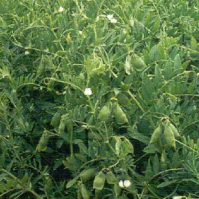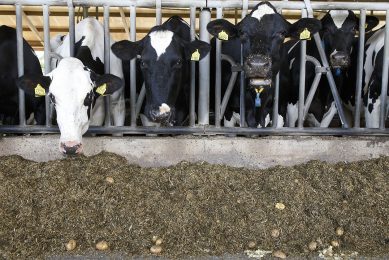Field peas do well in beef rations

Beef farmers in North Dakota have discovered field peas in feedlot rations. At time this pulse crop can outperform barley or corn and it improves the beef.
Ruminant nutritionist Vern Anderson has been studying field peas for 8 years
now at the Carrington Research Extension Center of North Dakota State
University.
|Many growing rations for bulls in North Dakota now contain
20% to 30% lightly rolled field peas because of the muscle development and
growth rates they produce.
Roll the peas
Some trials
compared the intake and performance of calves fed at arrival on pea-based or
barley/canola meal concentrate. The peas were lightly rolled or cracked as
Anderson had already discovered rolled peas were more easily digested than
ground or whole peas.
At 1.6 kg/head/day steers on a straight pea
concentrate had significantly higher gain and dry matter intake than steers on a
half and half mix or a barley only check ration.
“Now, with 60% of a
ration as concentrate and 100% of that concentrate being field peas, well that’s
a lot of peas. The good news is the calves ate it and digested it, grew and did
not have any problems. So peas are very palatable and they worked,” says
Anderson.
Same performance in finishers
In his trials
Anderson found higher dry matter intakes and daily gains with field peas in
growing rations compared to a standard barley/canola meal growing
ration.
Using field peas in finishing diets did not give better growth or
feed efficiencies, but marbling scores went up and the percentage Choice grading
carcasses almost doubled in the field peas fed animals compared to barley/canola
meal rations.
Tender and tastier beef
In a study 117 yearling
heifers were fed finishing rations containing 0, 10, 20 or 30% field peas in a
corn-based diet for 76 days. There were no discernable effects on carcass traits
but when a panel of expert tasters ate the beef, the field pea-finished steaks
proved superior on juiciness and tenderness.
It seems the effect on
juiciness plateaus at about 20% field pea while it kept trending upwards to the
30% level on tenderness ratings.
“If we can improve the juiciness and
tenderness of beef by feeding peas even at a modest 10% rate for as little as 2
months and get this kind of impact, well this is truly exciting stuff,” Anderson
says.











